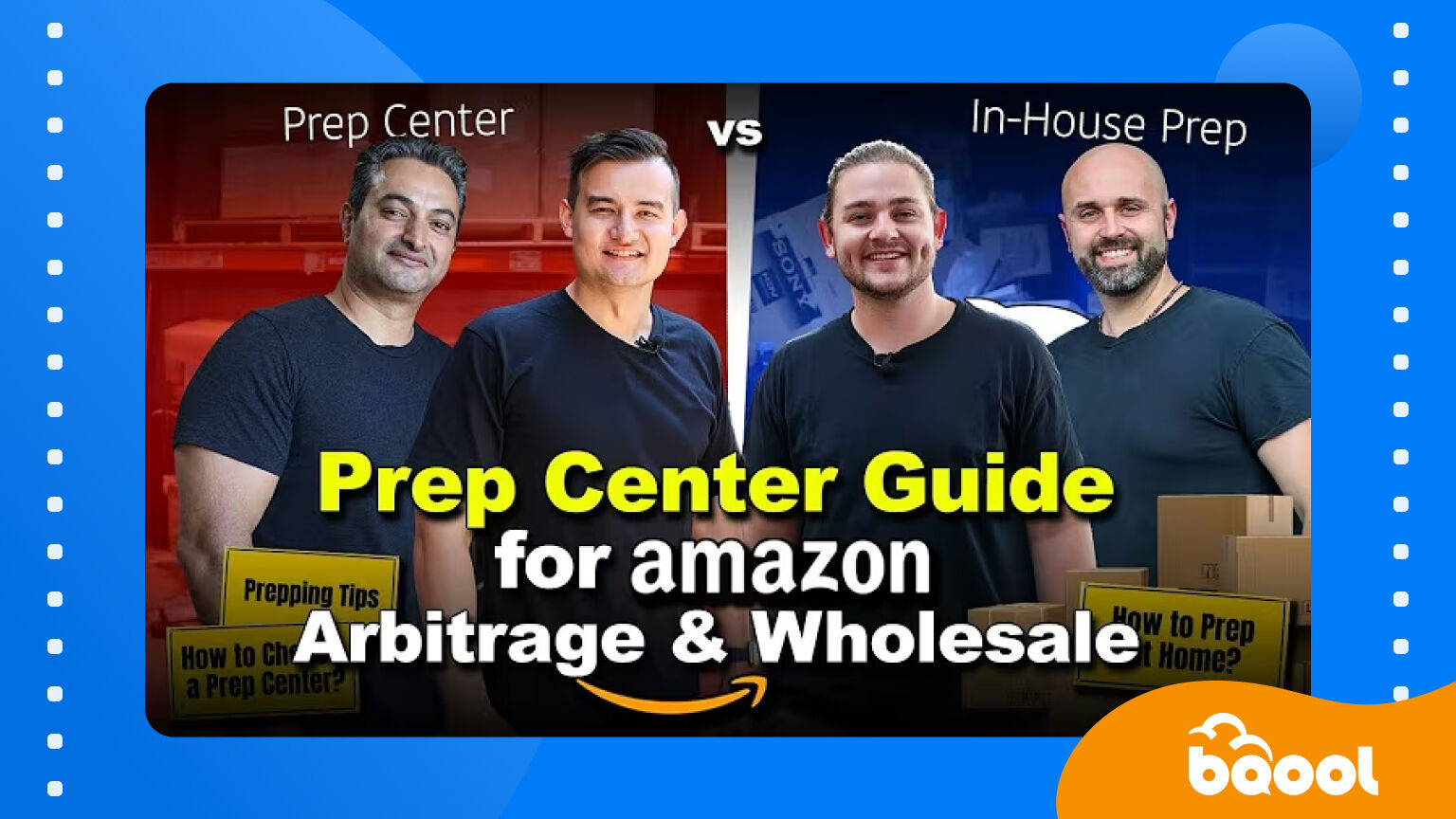How To Succeed At Amazon Wholesale: Misha Fedorov’s Story
Many people dream of leaving the 9-to-5 grind and have pondered at how to succeed at an Amazon Wholesale business to make that dream come true. For Misha Fedorov, that dream became a reality. Just a few years ago, Misha was managing restaurants, working long hours, and spending little time with his family. Today, he runs a thriving Amazon wholesale business that generates over $4 million annually.
In a recent podcast interview, Misha shared his journey, the lessons he learned along the way, and practical advice for Amazon sellers looking to learn how to succeed at Amazon Wholesale. Here’s his story and the strategies that helped him scale.
Overview
From Restaurant Manager to Amazon Seller
Misha’s entrepreneurial journey began in 2011 after moving to the United States from Russia. Like many immigrants, he started with restaurant work and eventually moved up to management. For seven years, he dedicated himself to the food service industry, but the long hours left him with little family time.
When COVID-19 hit, Misha finally had the chance to pause and reflect. “I liked being home with my kids and family,” he recalls. That realization made him rethink his career path. He dove into the Amazon seller community on YouTube and Instagram, studying the model in depth and decided not to go back to restaurants.
The Leap Into E-Commerce
Misha had always tried side hustles from flipping cars to dropshipping, but Amazon stood out for its scale and longevity. After a restaurant deal fell through, he went all-in on Amazon with $30,000–$40,000 in savings and a one-year runway. Month by month, sales climbed from $3K to $5K, $8K, and $12K. In year two, armed with confidence and a better grasp of fees, he reinvested aggressively and scaled faster.
PRO TIP: Give yourself a defined test window (e.g., 6–12 months) and a clear budget. Review results monthly and reinvest profits into faster, repeatable winners.
Why Sellers Fail on Amazon
According to Misha, many new sellers fail because they don’t understand the numbers. Revenue screenshots aren’t profit. After Amazon fees, shipping, returns, and storage, margins shrink fast. Without meticulous expense tracking, sellers can be losing money, while adding credit card debt.
- Focus on net profit, not vanity revenue.
- Track every expense (even tape and boxes) in a simple weekly spreadsheet.
- Know your true unit economics before increasing ad spend or inventory.
Product Sourcing: RA → OA → Wholesale
- Retail Arbitrage (RA): Store-by-store scanning; works but not easily scalable.
- Online Arbitrage (OA): Retailers like Walmart and Kohl’s; scalable but competitive (teams of VAs).
- Wholesale: Relationships with distributors; bulk buys; now the core of Misha’s model.
Misha stresses wholesale isn’t the “final boss.” If RA/OA suits your resources and lifestyle, stick with it, the best model is the one you can execute consistently.
How He Chooses Wholesale Products
Misha relies on data from Keepa to decide how deeply to invest, starting small (12–24 units) with new brands and going deeper once proven.
He looks at:
- Sales rank history
- Buy Box price trends
- Number of competing sellers
- Buy Box rotation (how often sellers share sales)
Based on that data, he decides how deeply to invest. For new brands he hasn’t sold before, he starts small, maybe 12 to 24 units. But if he’s already had success with a brand, he’s confident enough to place larger orders.
QUOTE: “It doesn’t matter what the product is. As long as the data makes sense, I’ll buy it.”
Avoiding Pitfalls in Wholesale
One of the biggest risks is buying from unauthorized distributors. Amazon is strict on authenticity; bad sources can trigger suspensions or IP complaints.
- Buy directly from brands or authorized distributors.
- Call the brand to verify distributor legitimacy.
- Do “FBI research”: check LLC registrations, addresses, and social profiles.
How He Uses AI
While he doesn’t source with AI yet, Misha treats it like a junior VA to save time and reduce errors.
- Communication: Drafts professional emails to suppliers/customers.
- Supplier Verification: Analyzes sites/traffic; flags suspicious vendors.
- Customer Service: Prompt templates for common issues (e.g., package theft).
- Research Assistance: Finds alternative distributors when stock/prices shift.
PRO TIP: AI is only as good as your instructions. Create reusable prompts and SOPs so results stay consistent across the team.
Essential Tools for Amazon Sellers
When asked about his most important tools, Misha highlights two essentials:
- Keepa – for analyzing product performance and sales trends.
- BQool Repricer – to stay competitive on price without constant manual effort.
Before using BQool, Misha manually repriced every three days, averaging $500/day in sales. After automating with BQool, he saw his sales triple overnight.
Lessons for Aspiring Sellers
- Start small, grow steadily: Don’t risk everything upfront; reinvest profits.
- Focus on profit, not revenue: Track every fee and expense weekly.
- Data over emotion: Use Keepa and real unit economics to decide.
- Source responsibly: Stick to authorized distributors; protect your account.
- Leverage tools & AI: Automate repricing and standardize workflows.
Instant ROI Analyzer: Seeing your current margins on Amazon lets you quickly adjust your min and max prices and choose the right repricing rule.
Try it in Repricing Central.
Conclusion
Ultimately, Misha’s success is a testament to his business acumen and resilient mindset. He treats Amazon not as a get-rich-quick scheme but as a complex sandbox where you must play by the rules, adapt to changes, and always know your numbers.
If you want to learn more from Misha, you can find him on Instagram @MishaFlips, where he shares his knowledge and journey to help others in the Amazon community.
Wanna find out how to succeed at Amazon Wholesale? Watch the video below!
Many people dream of leaving the 9-to-5 grind and have pondered at how to succeed at an Amazon Wholesale business to make that dream come true. For Misha Fedorov, that dream became a reality. Just a few years ago, Misha was managing restaurants, working long hours, and spending little time with his family. Today, he runs a thriving Amazon wholesale business that generates over $4 million annually.
In a recent podcast interview, Misha shared his journey, the lessons he learned along the way, and practical advice for Amazon sellers looking to learn how to succeed at Amazon Wholesale. Here’s his story and the strategies that helped him scale.
Overview
From Restaurant Manager to Amazon Seller
Misha’s entrepreneurial journey began in 2011 after moving to the United States from Russia. Like many immigrants, he started with restaurant work and eventually moved up to management. For seven years, he dedicated himself to the food service industry, but the long hours left him with little family time.
When COVID-19 hit, Misha finally had the chance to pause and reflect. “I liked being home with my kids and family,” he recalls. That realization made him rethink his career path. He dove into the Amazon seller community on YouTube and Instagram, studying the model in depth and decided not to go back to restaurants.
The Leap Into E-Commerce
Misha had always tried side hustles from flipping cars to dropshipping, but Amazon stood out for its scale and longevity. After a restaurant deal fell through, he went all-in on Amazon with $30,000–$40,000 in savings and a one-year runway. Month by month, sales climbed from $3K to $5K, $8K, and $12K. In year two, armed with confidence and a better grasp of fees, he reinvested aggressively and scaled faster.
Why Sellers Fail on Amazon
According to Misha, many new sellers fail because they don’t understand the numbers. Revenue screenshots aren’t profit. After Amazon fees, shipping, returns, and storage, margins shrink fast. Without meticulous expense tracking, sellers can be losing money, while adding credit card debt.
- Focus on net profit, not vanity revenue.
- Track every expense (even tape and boxes) in a simple weekly spreadsheet.
- Know your true unit economics before increasing ad spend or inventory.
Product Sourcing: RA → OA → Wholesale
- Retail Arbitrage (RA): Store-by-store scanning; works but not easily scalable.
- Online Arbitrage (OA): Retailers like Walmart and Kohl’s; scalable but competitive (teams of VAs).
- Wholesale: Relationships with distributors; bulk buys; now the core of Misha’s model.
Misha stresses wholesale isn’t the “final boss.” If RA/OA suits your resources and lifestyle, stick with it, the best model is the one you can execute consistently.
How He Chooses Wholesale Products
Misha relies on data from Keepa to decide how deeply to invest, starting small (12–24 units) with new brands and going deeper once proven.
He looks at:
- Sales rank history
- Buy Box price trends
- Number of competing sellers
- Buy Box rotation (how often sellers share sales)
Based on that data, he decides how deeply to invest. For new brands he hasn’t sold before, he starts small, maybe 12 to 24 units. But if he’s already had success with a brand, he’s confident enough to place larger orders.
Avoiding Pitfalls in Wholesale
One of the biggest risks is buying from unauthorized distributors. Amazon is strict on authenticity; bad sources can trigger suspensions or IP complaints.
- Buy directly from brands or authorized distributors.
- Call the brand to verify distributor legitimacy.
- Do “FBI research”: check LLC registrations, addresses, and social profiles.
How He Uses AI
While he doesn’t source with AI yet, Misha treats it like a junior VA to save time and reduce errors.
- Communication: Drafts professional emails to suppliers/customers.
- Supplier Verification: Analyzes sites/traffic; flags suspicious vendors.
- Customer Service: Prompt templates for common issues (e.g., package theft).
- Research Assistance: Finds alternative distributors when stock/prices shift.
Essential Tools for Amazon Sellers
When asked about his most important tools, Misha highlights two essentials:
- Keepa – for analyzing product performance and sales trends.
- BQool Repricer – to stay competitive on price without constant manual effort.
Before using BQool, Misha manually repriced every three days, averaging $500/day in sales. After automating with BQool, he saw his sales triple overnight.
Lessons for Aspiring Sellers
- Start small, grow steadily: Don’t risk everything upfront; reinvest profits.
- Focus on profit, not revenue: Track every fee and expense weekly.
- Data over emotion: Use Keepa and real unit economics to decide.
- Source responsibly: Stick to authorized distributors; protect your account.
- Leverage tools & AI: Automate repricing and standardize workflows.
Try it in Repricing Central.
Conclusion
Ultimately, Misha’s success is a testament to his business acumen and resilient mindset. He treats Amazon not as a get-rich-quick scheme but as a complex sandbox where you must play by the rules, adapt to changes, and always know your numbers.
If you want to learn more from Misha, you can find him on Instagram @MishaFlips, where he shares his knowledge and journey to help others in the Amazon community.
Wanna find out how to succeed at Amazon Wholesale? Watch the video below!









